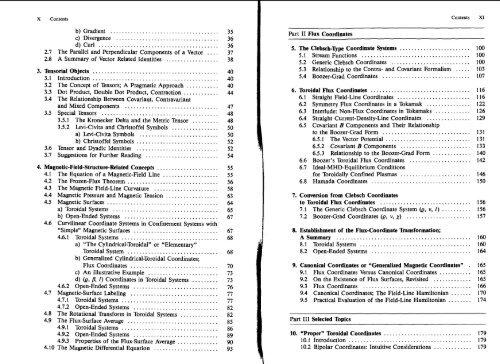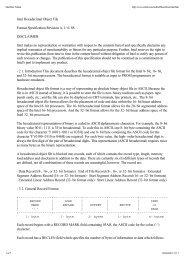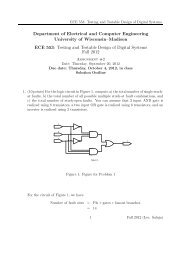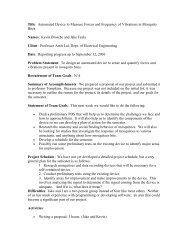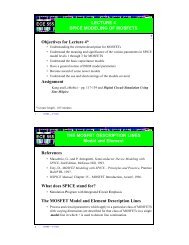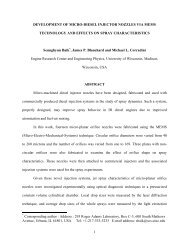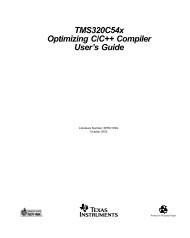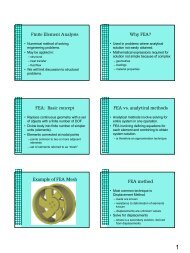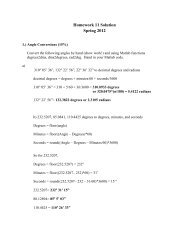Flux Coordinates and Magnetic Field Structure - University of ...
Flux Coordinates and Magnetic Field Structure - University of ...
Flux Coordinates and Magnetic Field Structure - University of ...
You also want an ePaper? Increase the reach of your titles
YUMPU automatically turns print PDFs into web optimized ePapers that Google loves.
X Contents<br />
b) Gradient .....................................<br />
c) Divergence ...................................<br />
d) Curl .........................................<br />
2.7 The Parallel <strong>and</strong> Perpendicular Components <strong>of</strong> a Vector ....<br />
2.8 A Summary <strong>of</strong> Vector Related Identities ..................<br />
3 . Tensorial Objects ...........................................<br />
3.1 Introduction ...........................................<br />
3.2 The Concept <strong>of</strong> Tensors; A Pragmatic Approach ...........<br />
3.3 Dot Product. Double Dot Product. Contraction ............<br />
3.4 The Relationship Between Covariant. Contravariant<br />
<strong>and</strong> Mixed Components ................................<br />
3.5 Special Tensors ........................................<br />
3.5.1 The Kronecker Delta <strong>and</strong> the Metric Tensor .........<br />
3.5.2 Levi-Civita <strong>and</strong> Christ<strong>of</strong>fel Symbols ................<br />
a) Levi-Civita Symbols ...........................<br />
b) Christ<strong>of</strong>fel Symbols ............................<br />
3.6 Tensor <strong>and</strong> Dyadic Identities ............................<br />
3.7 Suggestions for Further Reading .........................<br />
4 . <strong>Magnetic</strong>-<strong>Field</strong>-<strong>Structure</strong>-Related Concepts .....................<br />
4.1 The Equation <strong>of</strong> a <strong>Magnetic</strong>-<strong>Field</strong> Line ...................<br />
4.2 The Frozen-<strong>Flux</strong> Theorem ...............................<br />
4.3 The <strong>Magnetic</strong> <strong>Field</strong>-Line Curvature ......................<br />
4.4 <strong>Magnetic</strong> Pressure <strong>and</strong> <strong>Magnetic</strong> Tension ..................<br />
4.5 <strong>Magnetic</strong> Surfaces ......................................<br />
a) Toroidal Systems ....................................<br />
b) Open-Ended Systems ................................<br />
4.6 Curvilinear Coordinate Systems in Confinement Systems with<br />
"Simple" <strong>Magnetic</strong> Surfaces .............................<br />
4.6.1 Toroidal Systems .................................<br />
a) "The Cylindrical-Toroidal" or "Elementary"<br />
Toroidal System ...............................<br />
b) Generalized Cylindrical-Toroidal <strong>Coordinates</strong>;<br />
<strong>Flux</strong> <strong>Coordinates</strong> ..............................<br />
c) An Illustrative Example ........................<br />
d) (Q. /3. I) <strong>Coordinates</strong> in Toroidal Systems .........<br />
4.6.2 Open-Ended Systems .............................<br />
4.7 <strong>Magnetic</strong>-Surface Labeling ..............................<br />
4.7.1 Toroidal Systems .................................<br />
4.7.2 Open-Ended Systems .............................<br />
4.8 The Rotational lkansform in Toroidal Systems .............<br />
4.9 The <strong>Flux</strong>-Surface Average ...............................<br />
4.9.1 Toroidal Systems .................................<br />
4.9.2 Open-Ended Systems .............................<br />
4.9.3 Properties <strong>of</strong> the <strong>Flux</strong>-Surface Average ..............<br />
4.10 The <strong>Magnetic</strong> Differential Equation ......................<br />
Part I1 <strong>Flux</strong> <strong>Coordinates</strong><br />
Contents XI<br />
5 . The Clebsch-Type Coordinate Systems ........................ 100<br />
5.1 Stream Functions ..................................... 100<br />
5.2 Generic Clebsch <strong>Coordinates</strong> ........................... 100<br />
5.3 Relationship to the Contra- <strong>and</strong> Covariant Formalism ..... 103<br />
5.4 Boozer-Grad <strong>Coordinates</strong> 107<br />
..............................<br />
. ..................................<br />
.........................<br />
...............<br />
............<br />
...............<br />
6 Toroidal <strong>Flux</strong> <strong>Coordinates</strong> 116<br />
6.1 Straight <strong>Field</strong>-Line <strong>Coordinates</strong> 116<br />
6.2 Symmetry <strong>Flux</strong> <strong>Coordinates</strong> in a Tokamak 122<br />
6.3 Interlude: Non-<strong>Flux</strong> <strong>Coordinates</strong> in Tokamaks 126<br />
6.4 Straight Current-Density-Line <strong>Coordinates</strong> 129<br />
6.5<br />
6.6<br />
Covariant B Components <strong>and</strong> Their Relationship<br />
to the Boozer-Grad Form .............................. 131<br />
6.5.1 The Vector Potential ............................. 131<br />
6.5.2 Covariant B Components ........................ 133<br />
6.5.3 Relationship to the Boozer-Grad Form ............. 140<br />
Boozer's Toroidal <strong>Flux</strong> <strong>Coordinates</strong> ..................... 142<br />
6.7 Ideal-MHD-Equilibrium Conditions<br />
for Toroidally Confined Plasmas ........................ 146<br />
6.8 Hamada <strong>Coordinates</strong> 150<br />
..................................<br />
7 . Conversion from Clebsch <strong>Coordinates</strong><br />
to Toroidal <strong>Flux</strong> <strong>Coordinates</strong> ............................... 156<br />
7.1 The Generic Clebsch Coordinate System (Q. v. I) .......... 156<br />
7.2 Boozer-Grad <strong>Coordinates</strong> (Q. v. X) 157<br />
......................<br />
8 . Establishment <strong>of</strong> the <strong>Flux</strong>-Coordinate 'hnsformation;<br />
A Summary .............................................. 160<br />
8.1 Toroidal Systems ...................................... 160<br />
8.2 Open-Ended Systems .................................. 164<br />
9 . Canonical <strong>Coordinates</strong> or "Generalized <strong>Magnetic</strong> <strong>Coordinates</strong>" . 165<br />
9.1 <strong>Flux</strong> <strong>Coordinates</strong> Versus Canonical <strong>Coordinates</strong> ........... 165<br />
9.2 On the Existence <strong>of</strong> <strong>Flux</strong> Surfaces. Revisited ............. 165<br />
.....................................<br />
9.3 <strong>Flux</strong> <strong>Coordinates</strong> 166<br />
9.4 Canonical <strong>Coordinates</strong>; The <strong>Field</strong>-Line Hamiltonian ....... 170<br />
9.5 Practical Evaluation <strong>of</strong> the <strong>Field</strong>-Line Harniltonian ........ 174<br />
Part 111 Selected Topics<br />
. ..............................<br />
..........................................<br />
10 "Proper" Toroidal <strong>Coordinates</strong> 179<br />
10.1 Introduction 179<br />
10.2 Bipolar <strong>Coordinates</strong>: Intuitive Considerations ... ; ......... 179


